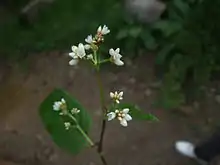Persicaria chinensis
Persicaria chinensis (synonym Polygonum chinense),[1] commonly known as creeping smartweed[2] or Chinese knotweed, is a plant species from the family Polygonaceae. It is widespread across China, Japan, the Indian Subcontinent, Indonesia, Malaysia, and Vietnam.[3] It is a common plant in Malaysia and Vietnam, where it is used in herbal remedies, such as for the treatment of dysentery, enteritis, and sore throat.[4] It is a weed in some coastal areas of New South Wales and Queensland in Australia.[5]
| Persicaria chinensis | |
|---|---|
 | |
| Scientific classification | |
| Kingdom: | Plantae |
| Clade: | Tracheophytes |
| Clade: | Angiosperms |
| Clade: | Eudicots |
| Order: | Caryophyllales |
| Family: | Polygonaceae |
| Genus: | Persicaria |
| Species: | P. chinensis |
| Binomial name | |
| Persicaria chinensis | |
| Synonyms[1] | |
| |
Persicaria chinensis is a perennial climber that grows to 2–3 m high. Its stems are glabrous and red-brown, with longitudinal stripes. Its leaves have oval blades, are 4–8 cm long and 3–5 cm wide, with pointed apex and round or nearly cordate base. Its cymes emerge at terminals, and are 5–7 cm long, with small white or pink flowers.[4]
References
- "Persicaria chinensis (L.) H.Gross". Plants of the World Online. Royal Botanic Gardens, Kew. Retrieved 2019-03-01.
- English Names for Korean Native Plants (PDF). Pocheon: Korea National Arboretum. 2015. p. 565. ISBN 978-89-97450-98-5. Archived from the original (PDF) on 25 May 2017. Retrieved 25 January 2016 – via Korea Forest Service.
- Flora of China, Polygonum chinense Linnaeus, 1753. 火炭母 huo tan mu
- Tanaka, Yoshitaka; Van Ke, Nguyen (2007). Edible Wild Plants of Vietnam: The Bountiful Garden. Thailand: Orchid Press. p. 121. ISBN 9745240893.
- Wilson, K.L. "New South Wales Flora Online: Persicaria chinensis". Royal Botanic Gardens & Domain Trust, Sydney, Australia.
External links
- Integrated Taxonomic Information System ITIS standard report, Polygonum chinense
- line drawing, Flora of China Illustrations vol. 5, fig. 248, 1
| Wikimedia Commons has media related to Persicaria chinensis. |